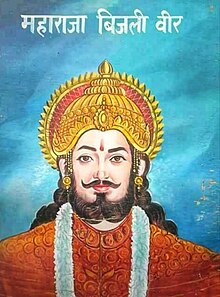Bijli Pasi
This article needs additional citations for verification. (March 2021) |
| Maharaja Bijli Pasi महाराजा बिजली पासी | |
|---|---|
| Maharaja of Bijnor | |
 | |
| Religion | Hinduism |
Maharaja Bijli Pasi was a king from the Pasi community, a Dalit caste in North India. He ruled during the Muslim period from a site located near Lucknow, and is believed to have constructed 12 forts in what is now the state of Uttar Pradesh.[citation needed]
Life[]

There is little to no historical record of Bijli Pasi's life. As belonging to Delhi-based medieval leader, Prithviraj Chauhan [1178-1192 CE], Bijli Pasi was the legendary figure responsible for the defense and morality of the Dalit people.[1][unreliable source?] Bijli Pasi was the one who founded the city of Bijnor in Uttar Pradesh, and was responsible for the success of his caste. Before the fall of the mighty empires of the past,[2] Bijli Pasi conquered his crown when North India was divided into smaller states.
The warrior representation of the Maharaja Pasi was created by the suggestion of Kanshi Ram, founder of the Bahujan Samaj Party. It is often seen on the walls of various Dalit communities, especially communities of the Pasi Caste. Kanshi Ram designed the image to contain the features of five Sikh gurus including Guru Arjan, Gobind Singh, and Guru Nanak, who are all worshiped by Dalit communities. Characteristics of the five gurus can be in the Maharaja's personality.[citation needed]
In popular culture[]
This section does not cite any sources. (March 2021) |
In 2000, the Government of India, Department of Posts - led by the Minister of Communications and Information Technology - issued a commemorative stamp to honor the social and political influence of the Pasi caste. The commemoration of Bijli Pasi gave legitimacy to the Dalit claim, which attests to the existence of multiple Dalit kings, often humble in origin but ending up with riches and privileges' reminiscent of today's upper castes. Uttar Pradesh is one of the states in which different castes are often in opposition, and therefore the commemoration of Bijli Pasi was a move towards empowering the Pasi caste.[citation needed]

See also[]
References[]
- ^ Badri Narayan (2012). Women Heroes and Dalit Assertion in North India: Culture, Identity and Politics. SAGE. p. 73. ISBN 9780761935377.
- ^ Gupta, Dipankar (2004). Caste in Question: Identity Or Hierarchy?. SAGE. ISBN 0761933247. Retrieved 2020-07-11.
- Dalit leaders
- Indian people